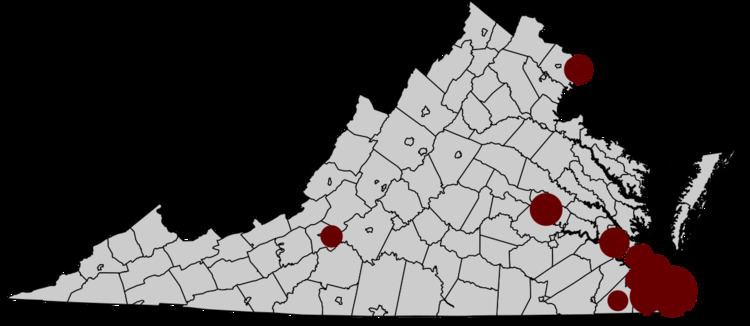 | ||
In the United States, an independent city is a city that is not in the territory of any county or counties with exceptions noted below.
Contents
- History
- Arlington County
- Former cities
- Other states
- Other entities similar to independent cities
- References
Of the 41 independent U.S. cities, 38 are in Virginia, whose state constitution makes them a special case. The three independent cities outside of Virginia are Baltimore, Maryland; St. Louis, Missouri; and Carson City, Nevada.
The U.S. Census Bureau uses counties as its base unit for presentation of statistical information, and treats independent cities as county equivalents for those purposes. Baltimore, Maryland is the largest independent city in the United States.
History
In the Commonwealth of Virginia, all municipalities incorporated as "cities" have been "independent cities", also called "free cities", since 1871, when a revised state constitution took effect following the American Civil War and the creation of West Virginia. Virginia's thirty-eight independent cities are not politically part of a county, even though geographically they may be completely surrounded by one. An independent city in Virginia may serve as the county seat of an adjacent county, even though the city by definition is not part of that county. Some other Virginia municipalities, even though they may be more populous than some existing independent cities, are incorporated towns. These towns always form part of a county. Incorporated towns have limited powers, varying by each charter. They typically share many aspects such as courts and public school divisions with the county they are within.
In the Commonwealth of Virginia, there are two classes of city. The primary difference relates to the court system. A first-class city (e.g., Norfolk) has its own District Court and also its own Circuit Court. A second-class city (e.g., Fairfax City, Falls Church) has its own District Courts, but not its own Circuit Court. So, for example, Fairfax City shares a Circuit Court with Fairfax County, while Falls Church City shares a Circuit Court with adjacent Arlington County. In Virginia, a District Court is not a court of record, so all cases are heard by a judge; all jury trials are heard in a Circuit Court.
Three older Virginia counties, whose origins go back to the original eight shires of Virginia formed in 1634 in the Colony of Virginia, have or had the word city in their names; politically, however, they are counties. The independent cities were formed to centralize trading and legal matters as the older system of merchant ships cruising from plantation to plantation was inefficient. The colonial capital of Williamsburg was created for this reason, being a port for the James River. Two of these counties are Charles City County and James City County, whose names originated with earlier "incorporations" created in 1619 by the Virginia Company as Charles Cittie and James Cittie. Another was Elizabeth City County, originally part of the older Elizabeth Cittie, which became extinct in 1952 when it was consolidated politically by mutual consent with the small City of Hampton, the county seat, and the Town of Phoebus to reform and expand into the current independent city of Hampton, Virginia, one of the large cities of Virginia.
Arlington County
Arlington County, commonly referred to as just "Arlington," is not an independent city. However, it is often thought of as a city. It is geographically small and dense, is fully urbanized, is close in size to other independent cities in the commonwealth (it would be the fourth-largest city if it were so incorporated), and has no incorporated municipalities within its borders. Due to the Byrd Road Act, it is one of two counties that maintains its own highway infrastructure like independent cities (the other being Henrico County). It consists solely of land ceded by Virginia to the Federal Government to form Washington, D.C., in the late 18th century, and retroceded to Virginia in 1846. (Most of this land now composes Arlington County; the rest of it forms part of the City of Alexandria.)
Former cities
Former independent cities now extinct that were long extant in Virginia include:
Two other independent cities existed only for a short time:
Other states
Some states have created independent cities in order to cater to the special requirements of governing their largest cities and/or capitals:
Other entities similar to independent cities
An independent city is not the same as:
